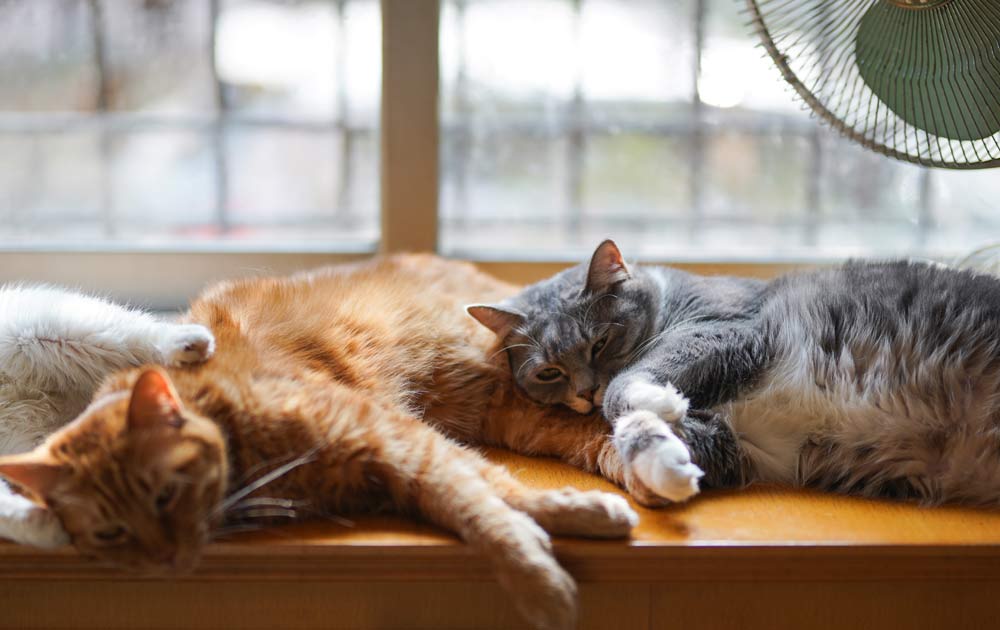How to improve your cat’s behavior? Before delving into strategies to address your cat’s behavior, it’s essential to grasp the intricacies of feline behavior. Cats are not just pets; they are sentient beings with distinct personalities and behavioral traits. Each cat is unique, exhibiting behaviors shaped by a combination of genetics, upbringing, and individual experiences. Understanding the underlying motivations behind your cat’s actions is paramount to effectively addressing any behavioral issues they may display.
Individuality of Cats
Just like humans, cats have their quirks and preferences that make them unique. Some cats may be outgoing and social, while others are more reserved and independent. Factors such as breed, age, and past experiences can also play a significant role in shaping a cat’s behavior. By recognizing and respecting your cat’s individuality, you can better understand their needs and tailor your approach to addressing any behavior issues they may have.
Importance of Observation
Observation is key to understanding your cat’s behavior. Pay attention to their body language, vocalizations, and interactions with their environment and other pets or people. Cats communicate primarily through non-verbal cues, so being attuned to their subtle signals can provide valuable insights into their thoughts and emotions. By observing your cat closely, you can identify patterns in their behavior and pinpoint any triggers or stressors that may be contributing to problematic behaviors.
Environmental Enrichment
Creating a stimulating and enriching environment is essential for a cat’s overall well-being and behavior. Provide plenty of opportunities for play, exploration, and mental stimulation to prevent boredom and frustration. This can include providing toys, scratching posts, perches, and hiding spots, as well as rotating toys and introducing new activities to keep your cat engaged and entertained. Additionally, ensure that your cat has access to a comfortable and safe space where they can retreat and relax when needed.
Positive Reinforcement
Positive reinforcement is a powerful tool for shaping and encouraging desired behaviors in cats. Reward your cat with treats, praise, or playtime when they exhibit positive behaviors such as using the litter box, scratching appropriate surfaces, or coming when called. By consistently rewarding good behavior, you can reinforce these behaviors and strengthen the bond between you and your cat. Avoid punishment or negative reinforcement, as this can lead to fear, anxiety, and aggression in cats.
How To Improve Your Cat’s Behavior in 14 Systematic Steps
Consistency and patience are crucial when working to modify your cat’s behavior. Be consistent in your expectations, rules, and routines, as cats thrive on stability and predictability. It may take time for your cat to learn new behaviors or unlearn old ones, so be patient and persistent in your efforts. Celebrate small victories and progress, and don’t get discouraged by setbacks or challenges along the way. With time, patience, and dedication, you can help your cat overcome behavior issues and build a strong and harmonious relationship.
Step 1: Observation and Analysis
Introduction: Observing your cat’s behavior is the first step in understanding and addressing any issues they may be experiencing. By closely monitoring their actions and reactions, you can gather valuable insights into their needs, preferences, and potential triggers for undesirable behavior.
Tips for Observation:
- Pay Attention: Dedicate time each day to observe your cat’s behavior without interruption. Take note of their interactions with their environment, other pets, and family members.
- Record Observations: Keep a journal or log to record your observations, including details such as the time of day, specific behaviors exhibited, and any potential triggers or stimuli present.
- Look for Patterns: Identify recurring patterns or trends in your cat’s behavior, such as certain behaviors occurring in response to specific events or stimuli. This can help pinpoint underlying causes and develop targeted solutions.
- Consult with Professionals: If you’re unsure about your observations or need additional guidance, consider consulting with a veterinarian or animal behaviorist for expert advice and assistance.
Outcome: By carefully observing and analyzing your cat’s behavior, you’ll gain valuable insights into their unique personality, preferences, and potential challenges. This information serves as the foundation for developing effective strategies to address any behavioral issues and enhance your cat’s overall well-being.
Step 2: Create a Safe Environment
Introduction: A safe and comfortable environment is essential for promoting your cat’s physical and emotional well-being. By creating a nurturing and secure space for your feline friend, you can help alleviate stress, prevent behavioral problems, and foster a sense of security and contentment.
Tips for Creating a Safe Environment:
- Provide Adequate Resources: Ensure your cat has access to essential resources such as food, water, litter boxes, scratching posts, and cozy resting areas. Place these resources strategically throughout your home to accommodate your cat’s needs and preferences.
- Minimize Stressors: Identify and minimize potential stressors in your cat’s environment, such as loud noises, unfamiliar scents, or aggressive pets. Create a calm and peaceful atmosphere by providing quiet retreats and avoiding sudden changes to their routine or surroundings.
- Offer Enrichment Activities: Stimulate your cat’s mind and body with engaging enrichment activities, such as puzzle feeders, interactive toys, and window perches. These activities provide mental stimulation, physical exercise, and opportunities for natural behaviors like hunting and exploring.
- Ensure Safety: Remove or secure any hazards or potential dangers that could pose a risk to your cat’s health and safety. This includes securing windows and balconies, keeping toxic plants out of reach, and safely storing household chemicals and medications.
Outcome: By creating a safe and supportive environment for your cat, you lay the foundation for their overall health, happiness, and well-being. A nurturing environment promotes positive behaviors, reduces stress, and strengthens the bond between you and your feline companion.
Step 3: Establish Routine
Introduction: Establishing a consistent daily routine is essential for providing structure and stability in your cat’s life. Cats thrive on predictability, and a regular schedule can help reduce stress, anxiety, and behavioral problems. By setting a routine for feeding, playtime, and other activities, you create a sense of security and comfort for your feline friend.
Tips for Establishing Routine:
- Set Fixed Meal Times: Feed your cat at the same times each day to establish a regular feeding schedule. This helps regulate their appetite, prevents overeating, and encourages healthy eating habits.
- Designate Playtime: Schedule daily play sessions with your cat to provide mental stimulation, exercise, and bonding opportunities. Use interactive toys, laser pointers, or feather wands to engage your cat in active play.
- Maintain Consistent Bedtime: Establish a bedtime routine for your cat by providing a comfortable sleeping area and dimming the lights in the evening. Encourage relaxation and restfulness before bedtime to promote quality sleep.
- Stick to the Schedule: Be consistent and reliable in following your cat’s daily routine. Avoid sudden changes or disruptions whenever possible, as this can cause stress and confusion for your cat.
Outcome: By establishing a consistent daily routine for your cat, you create a predictable and structured environment that promotes their overall well-being. A stable routine helps reduce anxiety, enhances their sense of security, and fosters positive behaviors and interactions with you and other household members.
Step 4: Positive Reinforcement
Introduction: Positive reinforcement is a powerful training technique that involves rewarding desired behaviors to encourage their repetition. By using rewards such as treats, praise, or playtime, you can reinforce good behavior in your cat and strengthen the bond between you.
Tips for Positive Reinforcement:
- Identify Desired Behaviors: Determine which behaviors you want to encourage in your cat, such as using the litter box, scratching posts, or coming when called.
- Choose Rewards: Select rewards that are highly motivating for your cat, such as their favorite treats or toys. Experiment with different types of rewards to see what elicits the strongest response.
- Timing is Key: Deliver the reward immediately after your cat exhibits the desired behavior to reinforce the connection between the behavior and the reward. This helps your cat understand which actions are being rewarded.
- Be Consistent: Consistency is crucial in positive reinforcement training. Reward your cat every time they demonstrate the desired behavior, and withhold rewards for unwanted behaviors. This helps clarify expectations and reinforces positive habits.
Outcome: By using positive reinforcement, you can effectively teach your cat new behaviors and reinforce existing ones in a gentle and rewarding manner. Positive reinforcement builds trust, strengthens the bond between you and your cat, and promotes a harmonious and cooperative relationship based on mutual respect and understanding.
Step 5: Avoid Punishment
Introduction: Punishment is not an effective or humane way to correct your cat’s behavior. It can lead to fear, anxiety, and aggression, damaging the bond between you and your feline friend. Instead of resorting to punishment, focus on positive reinforcement and redirection to encourage desirable behaviors.
Tips for Avoiding Punishment:
- Understand the Consequences: Punishment can have long-lasting negative effects on your cat’s emotional well-being and behavior. It may lead to fear, avoidance, or even aggression, making the problem worse.
- Use Positive Reinforcement: Focus on rewarding desired behaviors with treats, praise, or playtime. Positive reinforcement encourages your cat to repeat those behaviors in the future without the need for punishment.
- Redirect Unwanted Behavior: When your cat engages in undesirable behavior, such as scratching furniture or biting, calmly redirect their attention to an appropriate alternative, such as a scratching post or interactive toy.
- Create a Safe Environment: Minimize opportunities for unwanted behavior by removing temptations and providing appropriate outlets for your cat’s natural instincts, such as scratching posts and climbing trees.
Outcome: By avoiding punishment and focusing on positive reinforcement, you create a supportive and nurturing environment for your cat to thrive. Your feline friend will feel safe, secure, and loved, leading to better behavior and a stronger bond between you.
Step 6: Provide Mental Stimulation
Introduction: Mental stimulation is essential for keeping your cat happy, healthy, and well-behaved. Cats are intelligent creatures with natural instincts for hunting, exploring, and problem-solving. Providing opportunities for mental stimulation helps satisfy these instincts and prevents boredom and destructive behavior.
Tips for Providing Mental Stimulation:
- Interactive Toys: Invest in interactive toys that encourage your cat to play and explore. Toys with hidden treats or moving parts stimulate your cat’s natural hunting instincts and provide hours of entertainment.
- Puzzle Feeders: Use puzzle feeders or treat-dispensing toys to make mealtime more engaging. These devices require your cat to work for their food, providing mental stimulation and preventing overeating.
- Environmental Enrichment: Create an enriched environment for your cat with perches, hiding spots, and vertical space to explore. Rotate toys and rearrange furniture regularly to keep things interesting.
- Training and Tricks: Teach your cat new tricks or behaviors to challenge their mind and strengthen your bond. Simple commands like “sit” or “high five” can be taught using positive reinforcement techniques.
Outcome: By providing mental stimulation for your cat, you help fulfill their instincts and prevent boredom-related behavioral issues. Your cat will be happier, more fulfilled, and less likely to engage in destructive behaviors, leading to a harmonious and enriching relationship between you and your feline friend.
Step 7: Address Medical Issues
Introduction: Changes in your cat’s behavior can sometimes be a sign of underlying medical issues. If your cat’s behavior suddenly changes or becomes problematic, it’s essential to rule out any health problems that may be causing or contributing to the behavior.
Tips for Addressing Medical Issues:
- Schedule a Veterinary Visit: Make an appointment with your veterinarian to discuss your cat’s behavior and any concerns you may have. Your vet can perform a thorough physical examination and may recommend additional tests or diagnostics to identify any underlying medical issues.
- Describe Behavior Changes: Provide your veterinarian with detailed information about your cat’s behavior changes, including when they started, how often they occur, and any other relevant details. This information can help your vet determine the best course of action.
- Follow Treatment Recommendations: If your veterinarian identifies a medical issue, follow their treatment recommendations carefully. This may include medications, dietary changes, or other interventions to help manage your cat’s condition and improve their behavior.
- Monitor Progress: Keep track of any changes in your cat’s behavior or symptoms after starting treatment. Be sure to report any improvements or worsening of symptoms to your veterinarian so they can adjust the treatment plan as needed.
Outcome: By addressing any underlying medical issues, you can help improve your cat’s overall health and well-being, leading to better behavior and quality of life.
Step 8: Socialization
Introduction: Socialization is a crucial aspect of raising a well-adjusted and confident cat. Exposing your cat to various environments, sounds, people, and animals from a young age can help prevent fearfulness and aggression and promote positive interactions with others.
Tips for Socializing Your Cat:
- Start Early: Begin socializing your cat as early as possible, ideally during the kittenhood stage when they are most receptive to new experiences.
- Gradual Exposure: Introduce your cat to new environments, sounds, and experiences gradually and in a controlled manner. Start with quiet, familiar settings and gradually expose them to new stimuli over time.
- Positive Reinforcement: Use treats, praise, and play to reward your cat for calm and confident behavior during socialization experiences. Positive reinforcement helps your cat associate new experiences with positive outcomes.
- Respect Boundaries: Pay attention to your cat’s body language and comfort level during socialization experiences. Allow them to approach new people and animals at their own pace, and provide a safe retreat if they become overwhelmed.
- Consistency: Make socialization a regular part of your cat’s routine, incorporating new experiences and interactions regularly to reinforce positive behaviors and build confidence over time.
Outcome: By socializing with your cat from a young age, you can help them feel more comfortable and confident in various situations, reducing the likelihood of fearfulness or aggression and promoting positive interactions with people and other animals throughout their lives.

Step 9: Manage Stress
Introduction: Identifying and managing sources of stress in your cat’s environment is crucial for maintaining their overall well-being and preventing behavioral problems. Cats can experience stress due to various factors, including changes in their routine, new environments, or conflicts with other pets. By minimizing stressors and providing a calming environment, you can help your cat feel more comfortable and secure. How AI, ChatGPT maximizes earnings of many people in minutes
Tips for Managing Stress:
- Identify Stress Triggers: Pay attention to situations or stimuli that seem to cause stress or anxiety in your cat. Common stress triggers may include loud noises, unfamiliar visitors, changes in routine, or conflicts with other pets.
- Provide Safe Spaces: Create designated safe spaces where your cat can retreat and relax when they feel stressed or overwhelmed. These spaces should be quiet, cozy, and inaccessible to other pets or household members.
- Use Calming Aids: Consider using calming pheromone diffusers, sprays, or collars to help reduce your cat’s anxiety and promote relaxation. These products mimic the natural pheromones that cats produce when they feel safe and secure, helping to create a calming environment.
- Maintain Routine: Stick to a consistent daily routine for feeding, playtime, and other activities to help your cat feel more secure and predictable. Avoid sudden changes or disruptions to their routine whenever possible.
- Provide Enrichment: Engage your cat in interactive play, puzzle toys, and other enrichment activities to help alleviate boredom and reduce stress. Physical and mental stimulation can help distract your cat from stressful situations and promote relaxation.
Outcome: By proactively managing stress in your cat’s environment, you can help prevent behavioral problems and promote their overall well-being and quality of life.
Step 10: Consistency is Key
Introduction: Consistency is essential when it comes to modifying your cat’s behavior. Cats thrive on routine and predictability, so it’s important to establish clear expectations and stick to them. By maintaining consistency in your training methods and reinforcement techniques, you can help your cat understand what is expected of them and encourage positive behavior. Motivation – Mind – Success – Thinking – Productivity – Happiness
Tips for Maintaining Consistency:
- Establish Clear Rules: Clearly define the rules and boundaries for your cat, such as where they are allowed to go in the house, what behaviors are acceptable, and what behaviors are not tolerated.
- Use Consistent Reinforcement: Be consistent in your use of reinforcement techniques, such as rewards for desired behaviors and redirection or ignoring for unwanted behaviors. Consistent reinforcement helps your cat understand which behaviors are rewarded and which are not.
- Stick to Routine: Maintain a consistent daily routine for feeding, playtime, and other activities. Cats feel more secure and confident when they know what to expect, so avoid sudden changes or disruptions to their routine whenever possible.
- Avoid Mixed Signals: Be mindful of the signals you send to your cat through your actions and reactions. Avoid sending mixed signals or inadvertently reinforcing unwanted behaviors by being consistent in your responses.
- Patience and Persistence: Changing behavior takes time and patience, so be prepared to stick with your training efforts even if progress seems slow. Be patient with your cat and celebrate small victories along the way.
Outcome: By maintaining consistency in your training methods and interactions with your cat, you can help reinforce positive behaviors and discourage unwanted ones, ultimately strengthening your bond and promoting a harmonious relationship.
Step 11: Seek Professional Help
Introduction: If you’re finding it challenging to address your cat’s behavior issues on your own, seeking professional help can provide valuable support and guidance. Certified animal behaviorists and veterinarians with expertise in cat behavior can offer specialized knowledge and tailored strategies to address your cat’s specific needs effectively. Business – Money Making – Marketing – E-commerce
Tips for Seeking Professional Help:
- Research Qualified Professionals: Look for certified animal behaviorists or veterinarians with experience in cat behavior. Check their credentials, certifications, and client reviews to ensure they have the expertise you need.
- Schedule a Consultation: Contact the professional to schedule a consultation to discuss your cat’s behavior issues. Be prepared to provide detailed information about your cat’s behavior, including when it started, how often it occurs, and any triggers or patterns you’ve observed.
- Follow Recommendations: Listen to the professional’s recommendations and guidance carefully. They may suggest behavior modification techniques, environmental changes, or medical interventions to address your cat’s behavior issues effectively.
- Implement Strategies: Implement the strategies and techniques recommended by the professional consistently and patiently. Keep track of your cat’s progress and communicate any changes or concerns with the professional as you work together to improve your cat’s behavior.
Outcome: Seeking professional help can provide you with the knowledge, resources, and support needed to address your cat’s behavior issues effectively. With the guidance of a qualified professional, you can develop a personalized plan to help your cat overcome their challenges and thrive.
Step 12: Monitor Progress
Introduction: Monitoring your cat’s progress is an essential part of addressing behavior issues and implementing behavior modification strategies. By tracking changes in your cat’s behavior over time, you can assess the effectiveness of your efforts and make adjustments as needed to continue progressing towards your goals. Health books, guides, exercises, habits, Diets, and more
Tips for Monitoring Progress:
- Keep Detailed Records: Keep a journal or record of your cat’s behavior, including any changes, improvements, or setbacks you observe. Note the frequency and intensity of specific behaviors, as well as any factors that may influence them.
- Track Changes: Pay attention to any changes in your cat’s behavior over time. Look for signs of improvement or worsening of behavior issues and identify any patterns or trends that may emerge.
- Assess Effectiveness: Evaluate the effectiveness of the strategies and techniques you’re using to address your cat’s behavior issues. Consider whether they’re having the desired impact and whether any adjustments or modifications may be necessary.
- Communicate with Professionals: If you’re working with a professional, such as a certified animal behaviorist or veterinarian, communicate regularly about your cat’s progress. Provide updates on any changes or developments and follow their recommendations for ongoing management and support.
Outcome: By monitoring your cat’s progress closely, you can track their behavior changes, assess the effectiveness of your interventions, and make informed decisions about adjusting your approach as needed. With patience, consistency, and diligence, you can help your cat overcome behavior issues and lead a happier, healthier life.
Step 13: Stay Positive
Introduction: Maintaining a positive attitude is crucial throughout the behavior modification process with your cat. Your feline friend can sense your emotions, so staying calm, patient, and optimistic creates a supportive environment for learning and growth. By focusing on progress and celebrating each step towards better behavior, you can reinforce positive outcomes and motivate both yourself and your cat. Fitness – Meditation – Diet – Weight Loss – Healthy Living – Yoga
Tips for Staying Positive:
- Focus on Progress: Acknowledge and celebrate the progress you and your cat make, no matter how small. Recognizing improvements reinforces positive behaviors and encourages continued effort.
- Practice Patience: Understand that behavior modification takes time and consistency. Be patient with your cat and yourself, and don’t get discouraged by setbacks or slow progress.
- Use Positive Reinforcement: Reward your cat’s desirable behaviors with treats, praise, and affection. Positive reinforcement strengthens the bond between you and your cat and encourages them to repeat those behaviors.
- Stay Calm: Maintain a calm and composed demeanor, especially during challenging situations. Your cat will respond better to a relaxed and confident presence, making it easier to address behavior issues effectively.
Outcome: By staying optimistic throughout the behavior modification process, you create a supportive and nurturing environment that fosters learning and growth for both you and your cat. Your attitude and approach play a significant role in shaping your cat’s behavior, so maintaining positivity is key to achieving long-term success. RPM 3.0 – 60% CONVERSION & Money for Affiliate Marketing
Step 14: Enjoy Your Bond
Introduction: Amidst the process of addressing behavior issues, it’s essential to cherish and enjoy the bond you share with your cat. Building a strong relationship based on trust, love, and mutual respect lays the foundation for effective behavior modification and enhances the overall well-being of both you and your feline companion.
Tips for Enjoying Your Bond:
- Quality Time Together: Set aside dedicated time each day to spend with your cat, engaging in activities you both enjoy. Whether it’s cuddling on the couch, playing with toys, or simply being in each other’s company, prioritize quality time together to strengthen your bond.
- Be Present: Be fully present and attentive when interacting with your cat. Put away distractions and focus on the moment, allowing yourself to fully appreciate the joy and companionship your cat brings into your life.
- Embrace Unique Moments: Cherish the unique quirks and behaviors that make your cat special. Celebrate their individuality and enjoy the little moments of connection and affection that occur throughout the day. Cat accessories on Amazon
- Practice Gratitude: Take a moment each day to reflect on the positive aspects of your relationship with your cat. Express gratitude for the love, companionship, and happiness they bring into your life, fostering a deeper appreciation for your bond.
Outcome: By prioritizing and nurturing your bond with your cat, you create a fulfilling and rewarding relationship that enriches both of your lives. While addressing behavior issues is important, fostering a strong connection built on love, trust, and understanding is ultimately what makes the journey worthwhile. Enjoying your bond with your cat enhances your overall well-being and creates lasting memories of companionship and joy.
Other Interesting Articles




